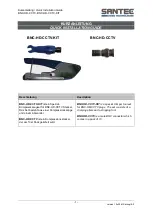
1
How to Use the Spindle Square
~~~~~~~~
IMPORTANT: Make sure power is off to the machine. The
Spindle Square should only be used when the power to
the machine is turned off.
~~~~~~~~
Calibrate
Place the Spindle Square on a known flat surface such as a surface plate
or the table of the milling machine (If it is flat and not damaged). Turn
the dials on the two indicators so that the needle on both indicators is on
the “0” position.
Note: Make sure that the dials both read “0” even if the needles do not
look parallel. The dial should show that both indicators are reading “0”
Adjust and Square the Head
1) Place the Spindle Square into the
collet of the milling machine and bring
the milling machine head down to the
table until both indicator needles have
rotated approximately one full rota-
tion. Now, adjust the machine as you
normally would until both indicators
are reading the same numerical value.
Note: It does not matter that the
needles do not point in the same direction. Identical numerical readings,
not the needle positions, are the values that determine squareness.
2) Bring the spindle up, turn the Spindle Square to the opposite axis and
repeat the same procedure as stated above. This will square the ‘Y’ axis.
3) Tram, or take sweep readings, on your mill. This is done by raising
the Spindle Square just enough so the indicator contact points will just
touch the milling table without interfering with the slots on the table when
sweeping the table. Now, slowly turn the Spindle Square and watch the
movement on the dial of one indicator only.
If the needle moves more than .001" on
the dial of that one indicator only, then
check that your tool-holding fixture in
your mill is not damaged. The Spindle
Square will alert you to a damaged or
nicked tool-holding fixture or collet
in your spindle by giving you an error
reading when tramming your head.
Remove the Spindle Square. Your mill is now ready to use.
Setting Angles with the Spindle Square
1. Square the axis which will not be set on the angle with the Spindle
Square using the directions above.
2. Mount the sine bar onto the milling machine table set to the angle
you want to use.
3. Bring down the spindle of the milling machine with the Spindle
Square touching the sine bar until both needles move approximately
one rotation.
4. Adjust the head of the milling machine until both indicators have
identical readings. Remember, it is the readings that must be identi-
cal, not the needle positions.
5. Once the readings are identical then the head is square to the sine
bar and is set to the proper angle. Your milling machine is ready to
use.
How do I know if my Spindle Square needs to be returned for
factory re-calibration?
Tram or take sweep readings after squaring your mill on the X and Y axis.
If you get an error reading (the needle on one indicator moves more than
.001"), do the following:
• Make sure that your tool-holding fixture or collet in your spindle is not
defective. You will get an error reading if there is a defective tool-holding
fixture in your spindle. The Spindle Square will let you know if you have a
faulty tool-holding fixture.
• If you don’t have any burrs, nicks, dings, or damage in your tool-holding
fixture then your Spindle Square may need to be factory re-calibrated.
starrett.com • 978.249.3551
How to Use the Spindle Square
Cómo usar el medidor Spindle Square
Notice d’utilisation pour le Spindle Square
Gebrauch des Spindle Square
649 Spindle Square
™






















